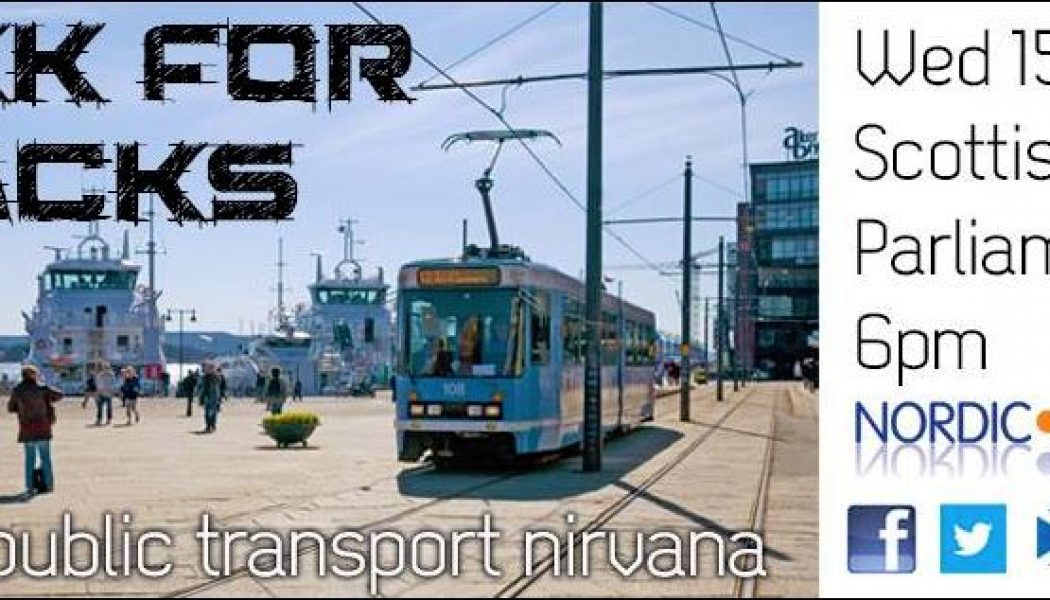Takk for Trams – Digital Notes

Oslo –public transport Nirvana
Hanne Bertnes Norli from Ruter
Weds January 15th 2014
Members Restaurant, Scottish Parliament 6-8pm
Hosted by Gordon Macdonald MSP
Chaired by journalist and NH Director Lesley Riddoch
Background
Oslo, Edinburgh and Glasgow have a lot in common. The population of the Norwegian capital is 593k, Edinburgh 495k and Glasgow 598k. But Oslo transport leaves its Scottish cousins standing with 6 cross-city tram lines with 99 stops, 6 cross-city underground train lines, 60 bus lines and 6 passenger ferry lines to neighbouring towns and the peninsula of Nesodden. Car transport is not forbidden – there’s an expanding network of inner city tunnels — but it’s taxed. Drivers are charged (roughly £3) every time they enter the city. All Oslo public transport — buses, trams, underground trains (t-bane), ferries and local trains – are part of the same ticket and price system.
The Oslo Tramway is a 131 kilometre network with daily passenger numbers of 110,000. The new Edinburgh line will be just 14 kilometres long. Oslo electric trams began in 1894 but after World War II, diesel buses started to replace trams, line closures began in 1947 and in 1960 the city council voted to dismantle the entire system in favour of buses. But in 1977 trams were saved and new rolling stock was ordered to supplement the aging fleet. In 1995 a line to the refurbished waterfront at Aker Brygge was opened (connecting with ferries to nearby towns and the peninsula of Nesodden) and in 1999 an existing line was extended to the University of Oslo campus and the new Rikshospitalet national hospital – precisely the kind of destinations included in the original two line proposal for Edinburgh.
So what saved Oslo trams in 1977? How can Oslo afford so much public transport — much of it installed before the oil began to flow? Does road pricing work and why is Oslo spending millions on tunnels to bring cars into the inner city? And does bus deregulation make it impossible for out cities to emulate Oslo today?
Presentation
Hanne Bertnes Norli works for Ruter – the public transport authority which issues contracts for all public transport in Oslo.
Her slide presentation is available for download here. Download ‘Ruter in Edinburgh’ (approx 8 Mb )
Takk for Trams – The Chairs Thoughts
Great Nordic Horizons event with the irrepressible Hanne Norli from Oslo transport operators Ruter. I confessed I was in love with their wee integrated handbook which I used daily over four months living in Olso a few years back. She confirmed they’re going to scrap it (aargh!) because ticketing’s gone online with an award winning app that already accounts for 17% of tickets sold. Progress ochone. Mind you 98% passenger satisfaction is hard to beat – especially when you shift the number of people Ruter shift – over 134kms of tram for example – not just 14kms as Edinburgh will soon have. Ruter are achieving those levels of happiness despite having to answer to a large number of political “owners” (two country and 23 municipal councils) and despite redesigning contracts so city buses increasingly terminate travellers at stations instead with the aim of shifting bus and tram commuters onto rail to avoid the congestion caused by multiple transport modes travelling side by side.
Pensioners don’t get free travel “unless they’re sick.” (Biggest laugh of the night)
And Hanne was big enough to admit that even Oslo have made mistakes with trams. The old one built in 1970s still work but new ones in 1990s were too heavy for the rails and have easy-to-rust buggies beneath. Lots of money spent on maintenance. They’ve also spent 15 years haggling over a much-needed new line to Fornebu which has just been approved. If Oslo gets the 2022 winter Olympics they will finally have a real deadline.
But Ruter’s great achievement is a constantly rising share of public transport journeys and flatlining car use – both in the city and in surrounding rural Akershus. Road tolling (introduced without a referendum!) funds much of the public transport upgrades. Though the biggest changes ahead will need extra cash. The Highways Authority has calculated there will need to be new rail lines and tunnels to carry the projected increase in population by 2030 or 10 extra lanes on motorways. That focuses the mind!
But like us many of Oslo’s actual services are provided by private operators. The biggest difference was picked up by Swedish Consul Torvald Colliander cos the same system operates in Sweden (and maybe Denmark?) Private operators are told what services the state/council wants, paid a set fee to deliver them and then all the revenue comes to the local authority. So it doesn’t matter if a route is hardly used or “uneconomic” — at least not to the private operator. They just do what they’re told. Here it seems the boot is always on the other foot. Operators like Scotrail carry only “management risk” – the track is effectively state-owned and the rolling stock is not Scotrail owned either as far as I understand it.
Couldn’t Scotland change the system to regain some control over prices/ planning and city growth? While Scottish cities often seem to have unplanned development, Oslo is having a public transport led development programme with the planners at Ruter and the Highways Authority projecting the hard choices to be made between now and 2060. Those long term visions guide strategy until 2030 and actions over the next five years. It all just makes SENSE.
And here’s a timely feature by the BBC .
Soundcloud Podcasts
An audio recording of the event was made.
Download Hanne Bertnes Norli presentation
In the second section of the audio recording, Hanne answers questions from the audience. This section is just over one hour long.
Download Hanne Bertnes Norli QandA





